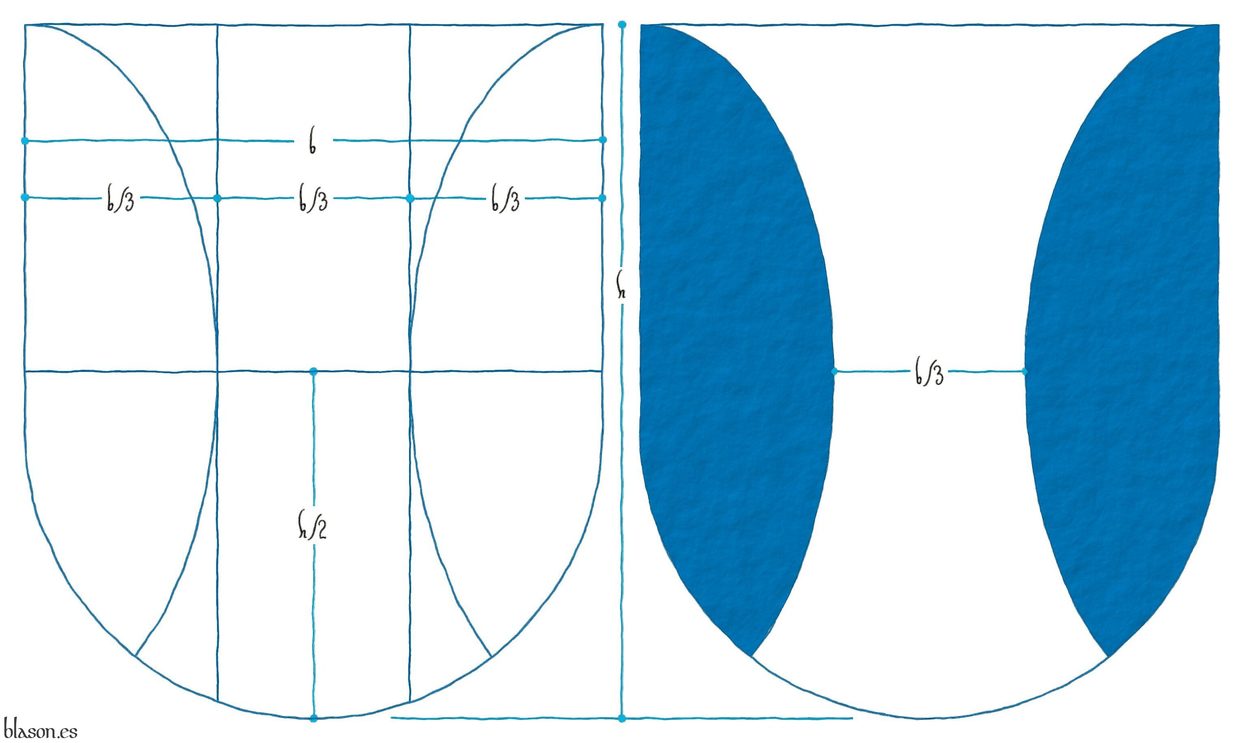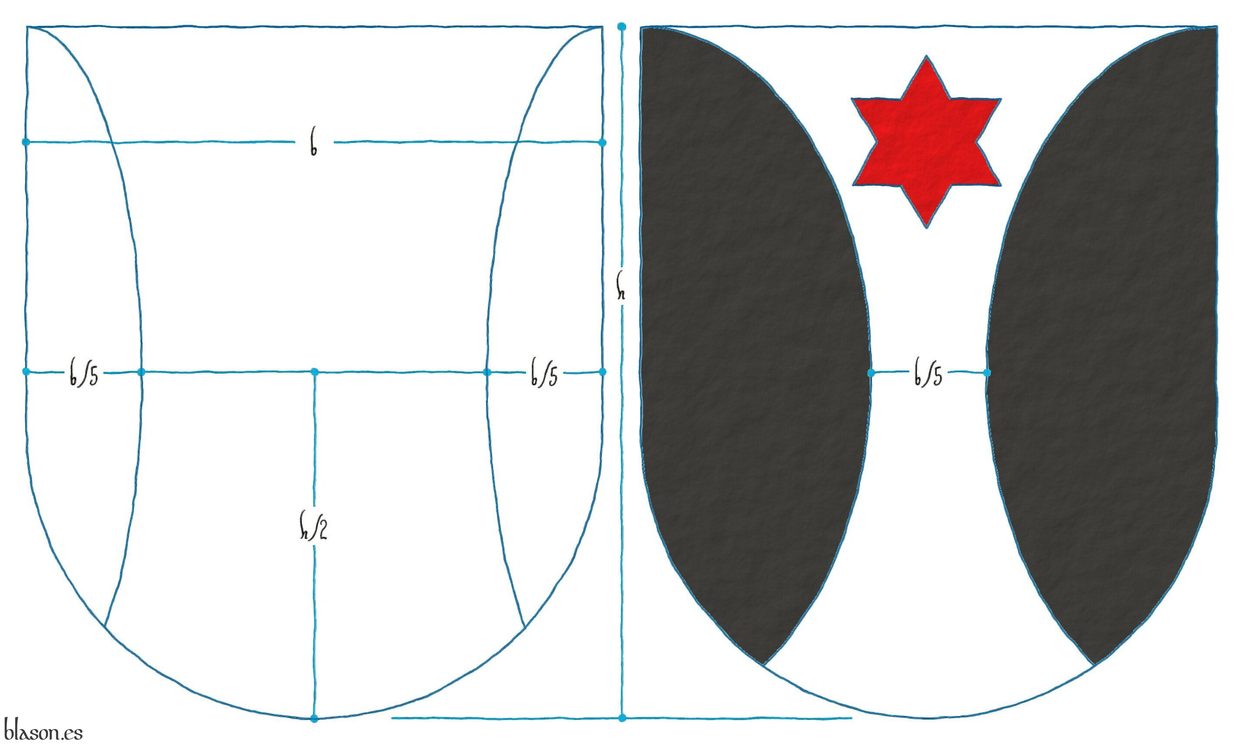![Ver [Flanched, schemaat one-third] en criterios utilizados. Unicornio saltante sobre la divisa, criterio.](../css/Unicornio.Criterio.png)
Flanched, schemaat one-third
Outlines and proportions of a flanched design at one-third.
This is my standardized way of delineating curved flanches, so that they remain tangent to a pale and, therefore, the width of both curved flanches and the space between them is equal to one third of the base. Some draw the flanches using circles, but I believe they look better as two half-ovals, which together would form a complete oval, with the height equal to that of the shield and the width two thirds of the base of the shield, that is, one third for each of the flanches, as in the figures illustrating this article. However, it should be noted that, depending on the charges, the separation distance may be adjusted.
Types of flanched designs
The «flanqueado curvo» corresponds to «flanched» in English, since for them the curved form is the default. [Avilés, J.; 1725b; page 92, figure 197] calls it «flanqueado en óvalo».
The «flanqueado apuntado» formed by 2 opposed triangles I call «pointed flanched» in English, as I have not found a better term. [Avilés, J.; 1725b; page 92, figure 198] calls it «flanqueado en sotuer», but what he draws in his book actually corresponds to a «cuartelado en sotuer» since the two points of the flanking meet at the center of the coat of arms.
«Flanqueado» without adjectives corresponds in Castilian to an «adiestrado» as opposed to a «siniestrado», and I refer to it in English as «flanked by two pales» having found no better translation.
Blazon keywords: Flanched.
Style keywords: Semi-circular.
Classification: Criterion and Schema.
Bearer: Oschoven of the Rhin.


Flanched, schemaat one-fifth
Outlines and proportions of a flanched design at one-fifth.
Regarding the flanched design, [Avilés, J.; 1725a; page 92] writes: «it is said of a figure that divides the Shield from the side of the flanks, sometimes by means of half-ovals», such as those in the diagram that illustrates this article, «and other times by means of half-lozenges, which run from the angle of the Chief to the angle of the base on the same side, whence they take their beginning».
In [Avilés, J.; 1725a; figure 197] an example of a flanched shield is illustrated with the arms of Oschoven on the Rhine, where the space left between both flanches is 1/5 of the base of the shield and, therefore, the width of each flank is 2/5 of the base of the shield, being 2/5 + 1/5 + 2/5 equal to the full base.
Blazon keywords: Flanched.
Style keywords: Semi-circular.
Classification: Schema.
Bearer: Oschoven of the Rhin.


Oschoven of the Rhin
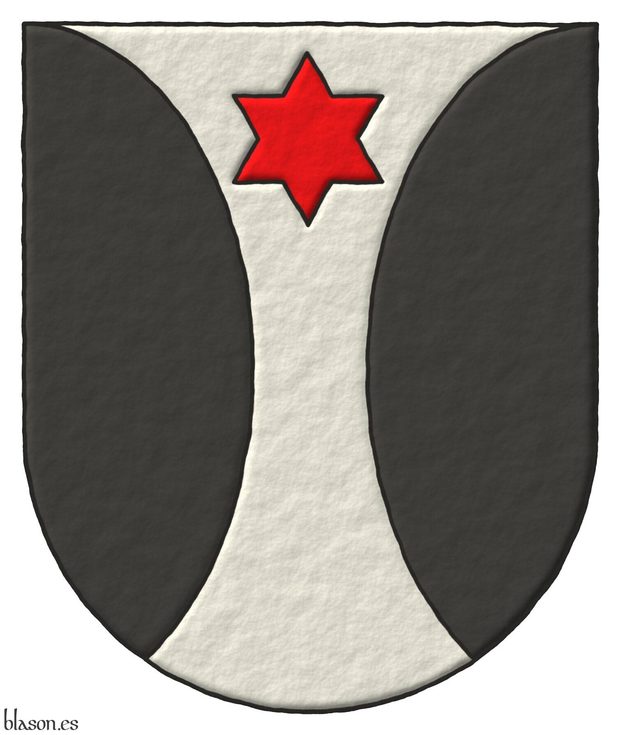
Argent, flanched Sable, in chief a mullet of six points Gules.
Escudo de plata, flanqueado curvo de sable, en jefe una estrella de seis rayos de gules
Coat of arms interpreted with: a semicircular (round) base; illuminated in the tinctures Argent, Gules, and Sable; all outlined in Sable; and finished with a raised-stroke effect.
[Avilés, J.; 1725a; pages 92 and figure 197] blazons it as «Argent, and a six-pointed star Gules in chief, flanched in oval Sable». When he illustrates it in [Avilés, J.; 1725a; figure 197], the space left between both flanches is only 1/5 of the base of the coat of arms; this is feasible because the only charge is a mullet in chief. If there were more charges, it would be necessary to leave more space, for example, 1/3 of the base of the shield.
«Oschoven au Rhein» in the book [Menestrier, C. F.; 1659; page 315], it is blazoned «d'argent flanqué arrondi de sable à vne molette de mesme en chef», so the mullet would be Sable, bacause «de mesme» is written, and with a hole in the middle, this hole does not exits in other sources.
In the book [Rietstap, J. B.; 1861], it is blazoned «Argent, flanched in round Sable, Argent charged in chief of a mullet Gules», and in French «d'argent, flanqué en rond de sable, l'argent chargé en chef d'une étoile de gueules».
Some time ago I used to blazon it in English as «Argent, in chief a mullet of six points Gules, between two flanches Sable».
Blazon keywords: Argent, Sable, Gules, Mullet, Chief and Flanched.
Style keywords: Semi-circular, Illuminated, Outlined in sable and Freehand.
Classification: Interpreted and Personal.
Bearer: Oschoven of the Rhin.


Argote de Molina, Gonzalo
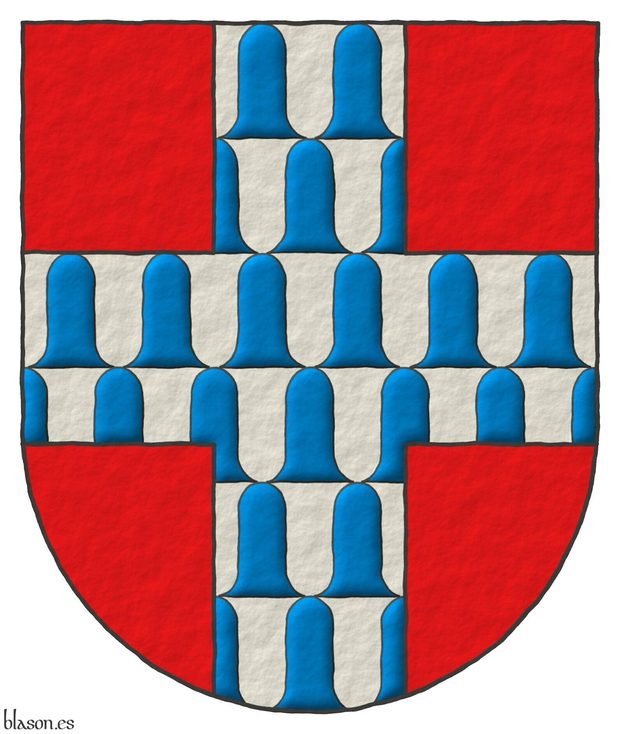
Gules, a cross vair ancient.
Escudo de gules, una cruz de veros antiguos.
Coat of arms that I have interpreted as follows: the shield has a semicircular (round) base; the field is in flat tincture of Gules; the ancient vair, rounded or of the old form, which are always Argent and Azure, are illuminated and outlined in Sable; and the whole of the hereditary coat of arms has a raised-stroke drawing.
Este escudo puede encontrarse en el libro del propio [Argote de Molina, G.; 1588; páginas 14 y 168], en la página 14 en grande, con cimera y rodeado de otros escudos de menor tamaño y en la página 168 de menor tamaño, con yelmo y lambrequines. En ambos casos el trazado de los veros es antiguo, redondeados, y en estas interpretaciones así los he reflejado.
Blazon keywords: Without divisions, Gules, Argent, Azure, Cross and Vair ancient.
Style keywords: Freehand, Illuminated and Outlined in sable.
Classification: Interpreted, Personal, Coat of arms and Heraldry and heralds.
Bearer: Argote de Molina, Gonzalo.


Gonzalo Argote de Molina
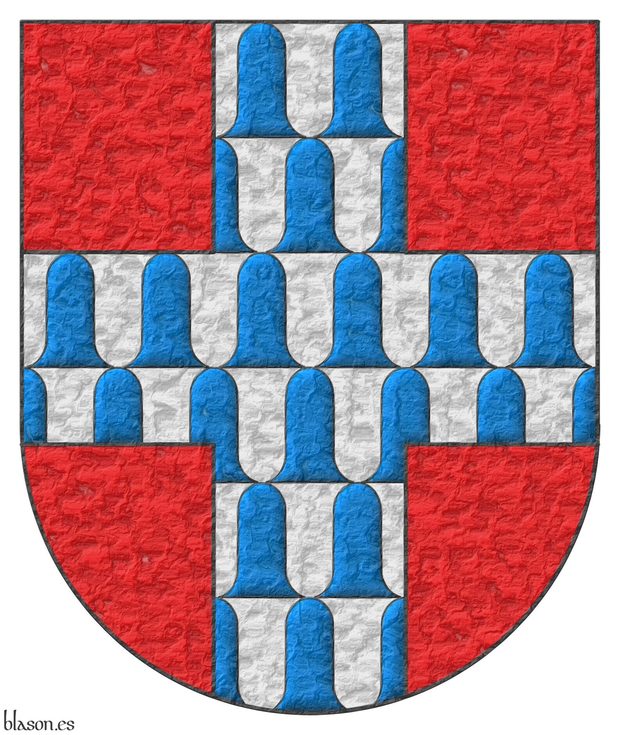
Gules, a cross vair ancient.
Escudo de gules, una cruz de veros antiguos.
Coat of arms that I have interpreted as follows: the shield has a semicircular (round) base; the field is in flat tincture of Gules; the vair ancient, rounded in the old style, are outlined in Sable and illuminated; and the whole has a raised-stroke drawing.
The coat of arms of the commune of Bailleul is very similar to this coat of arms, with the difference that it is of regular vair instead of ancient, rounded vair, like that borne by Gonzalo Argote de Molina.
Blazon keywords: Without divisions, Gules, Argent, Azure, Cross and Vair ancient.
Style keywords: Semi-circular, Illuminated, Outlined in sable and Metal beaten.
Classification: Interpreted, Personal, Coat of arms and Heraldry and heralds.
Bearer: Argote de Molina, Gonzalo.


Bailleul, commune of
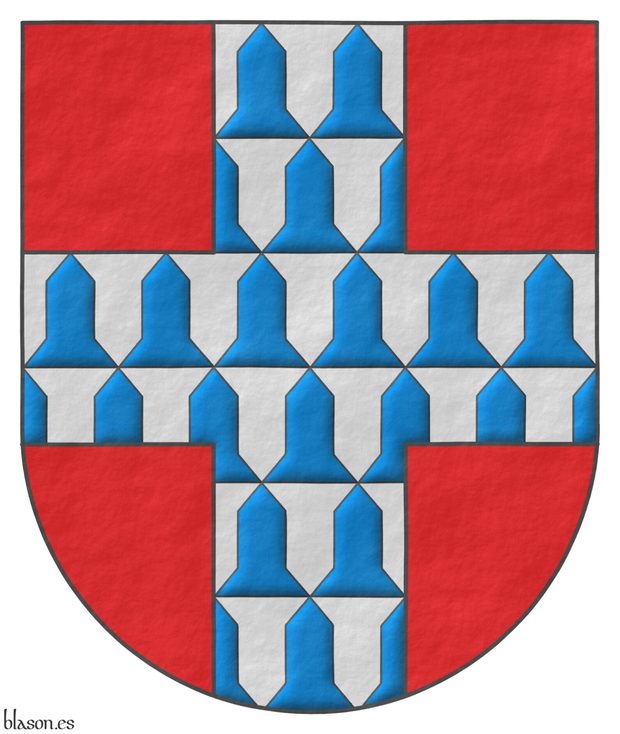
Gules, a cross vair.
Escudo de gules, una cruz de veros.
Coat of arms interpreted with: a semicircular (round) base; the field in flat tincture of Gules; the vair illuminated and outlined in Sable; and the whole with a roughened finish.
The commune of Bailleul is located in the district of Dunkirk, in the Nord department, in the Nord–Pas-de-Calais region of France.
The coat of arms of Bailleul, called «Belle» in Flemish, is similar to that of the heraldist Gonzalo Argote de Molina, differing in that the commune’s arms bear vair, while the heraldist’s arms bear rounded vair in the ancient style.
Blazon keywords: Without divisions, Gules, Argent, Azure, Cross and Vair.
Style keywords: Semi-circular, Illuminated, Outlined in sable and Rough.
Classification: Interpreted, Civic, Coat of arms and Kingdom of France.
Bearer: Bailleul, commune of.


Zúñiga y Guzmán, Álvaro de
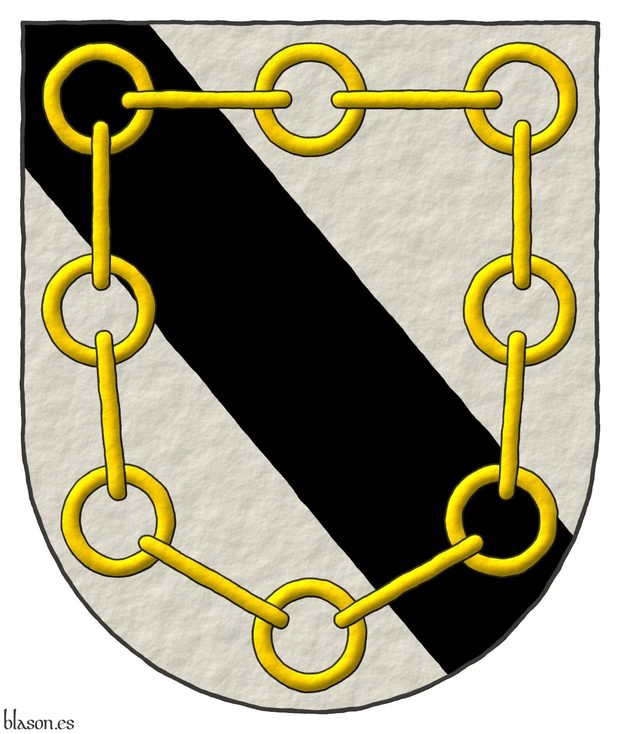
Justice and High Sheriff of Castile, first knight of the realm, warden of the fortress of Burgos, administrator of the mastership of the Order of Alcántara, nobleman of Castile, 1410–1488.
Argent, a bend Sable; overall a chain orlewise Or.
Escudo de plata, una banda de sable; brochante sobre el todo una cadena puesta en orla de oro.
Coat of arms of Álvaro de Zúñiga y Guzmán, which I have interpreted as follows: the shield has a semicircular (round) base; the field and the bend are illuminated in flat tinctures Argent and Sable; the chain is illuminated in Or; and the whole is rendered with a raised-stroke effect.
For the crafting of the chain in this coat of arms, which has a total of 16 links, of which 8 are long and 8 are round, I have followed the two coats of arms of Álvaro de Zúñiga y Guzmán that appear in what was his copy of [Alfonso X of Castile; 1265; page 6 of the later pencil numbering].
Blazon keywords: Without divisions, Argent, Sable, Or, One, Bend, Chain, Orlewise and Overall.
Style keywords: Freehand and Illuminated.
Classification: Interpreted, Personal and Coat of arms.
Bearer: Zúñiga y Guzmán, Álvaro de.


Álvaro de Zúñiga y Guzmán
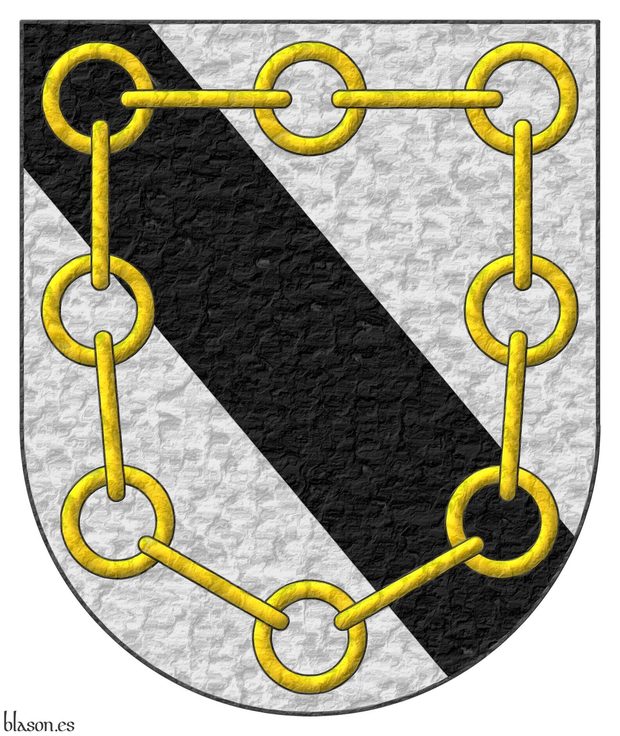
Lord of Zúñiga and Mendavia and of Béjar and Bañares and of Gibraleón, 1st Duke of Arévalo, 1st Duke of Plasencia, 1st Count of Bañares, 1st Duke of Béjar, 2nd Count of Plasencia, and Grandee of Castile.
Argent, a bend Sable; overall a chain orlewise Or.
Escudo de plata, una banda de sable; brochante sobre el todo una cadena puesta en orla de oro.
Personal coat of arms interpreted by me as follows: the shield has a semicircular (round) base; both the field and the bend have been illuminated in flat tinctures Argent and Sable; the links of the chain are enameled and illuminated in Or; and the whole is made of beaten metal.
In [Argote de Molina, G.; 1588; page 94 according to the numbering of the book, or page 93 according to the numbering accompanying the illustrations] this coat of arms appears under the title «Zúñigas» with the overlying chain formed only by 8 long links.
In [Anonymous; 1800a; page 46] the blazon of «the Zúñigas» is described, where in this book, curiously, the letter Z is ordered after C and before D.
Blazon keywords: Without divisions, Argent, Sable, Or, One, Bend, Chain, Orlewise and Overall.
Style keywords: Semi-circular, Illuminated and Metal beaten.
Classification: Interpreted, Personal and Coat of arms.
Bearer: Zúñiga y Guzmán, Álvaro de.

Continue with: Scheme of a bend and a bend sinister.
-
Language
-
Categories of heraldry
-
Divisions of the field
- Without divisions
- Party per pale
- Party per fess
- Party per bend
- Party per bend sinister
- Tierce
- Tierce sinister
- Tierced per pale
- Tierced per fess
- Tierced per bend
- Tierced pallwise inverted
- Quarterly
- Quarterly per saltire
- Gyronny
- Party per fess, the chief per pale
- Party per pale, the sinister per fess
- Party per fess, the base per pale
- Party per pale, the dexter per fess
- Chapé
- Chaussé
- Embrassé
- Contre-embrassé
- Party per chevron
- Enté
- Enté en point
- Flanched
-
Metals
-
Colours
-
Furs
-
Other tinctures
-
Ordinaries and sub-ordinaries
-
Diminutives of the ordinaries
-
Geometric charges
-
Composite ordinaries
-
Inanimate charges from Nature
Atom, Crescent, Diamond, Emerald, Estoile, Increscent, Lightning flash, Moon, Mount, Mullet, Mullet of four points, Orbital, Plough of Ursa Major, Rainbow, Ray of the sun, River, Sea, Snowflake, Sun, Sun in splendour, Sun of May, Trimount and Water.
-
Vegetal charges from Nature
Acorn, Apple, Apple tree, Ash, Bluebonnet, Camellia, Chrysanthemum, Cinquefoil, Cornflower, Dogwood flower, Double rose, Elm, Fleur de lis, Flower, Gourd, Holm oak, Hop cone, Kapok tree, Laurel, Lily, Linden, Lotus flower, Madonna lily, Oak, Olive tree, Palm tree, Pomegranate, Poplar leaf, Rose, Shamrock, Sunflower, Thistle, Tree, Tulip, Vine and Wheat.
-
Animal charges from Nature
Badger, Bald eagle, Barbel, Barn owl, Bear, Beaver, Beetle, Bighorn sheep, Blackbird, Boar, Brach hound, Bull, Doe, Dog, Dolphin, Dove, Eagle, Elephant, Falcon, Fish, Flame, Fly, Fox, Frog, Goat, Goldfinch, Goose, Heron, Horse, Hummingbird, Jaguar, Lark, Leopard, Lion, Lion passant, Lion rampant guardant, Lioness, Lynx, Male figure, Martlet, Merino ram, Owl, Panther, Parrot, Peacock, Pelican, Pelican in her piety, Puffin, Quetzal, Raven, Roe deer, Rooster, Savage, Seagull, Serpent, She-wolf, Stag, Starling, Talbot, Tyger, Vulture, Warren hound and Wolf.
-
Parts of natural charges
Arm, Beak, Branch, Caboshed, Chest, Claw, Covert, Dorsal fin, Eagle claw, Ermine spot, Escallop, Feather, Foot (palmiped), Foreleg, Forepaw, Hand, Head, Heart, Hoof, Leaf, Neck, Ostrich feather, Palm frond, Paw, Roe deers' attires, Shoulder, Sprig, Stags' attires, Stem, Swallow-tail, Tail, Tail addorsed, Tail fin, Talon, Tooth, Trunk, Trunk (elephant), Two hands clasped, Two wings in vol, Udder, Wheat spike, Wing and Wrist.
-
Artificial charges
Ace of spades, Anchor, Anvil, Arch, Arm vambraced, Armillary sphere, Arrow, Axe, Bell, Bell tower, Beret, Bonfire, Book, Bookmark, Bow, Bridge, Broken, Buckle, Cannon, Cannon dismounted, Cannon port, Canopy roof, Carbuncle, Castle, Celtic Trinity knot, Chain, Chess rooks, Church, Clarion, Clay pot, Closed book, Club, Comb, Compass rose, Conductor's baton, Cord, Covered cup, Crozier, Crucible, Cuffed, Cup, Cyclamor, Dagger, Double vajra, Drum, Ecclesiastical cap, Fanon, Federschwert, Fleam, Four crescents joined millsailwise, Galician granary, Garb, Gauntlet, Geometric solid, Grenade, Halberd, Hammer, Harp, Host, Hourglass, Key, Key ward, Knight, Knot, Lantern, Letter, Line, Loincloth, Menorah, Millrind, Millstone, Millwheel, Monstrance, Mortar, Mullet of six points pierced, Nail, Non-classic artifact, Norman ship, Number, Oar, Oil lamp, Open book, Page, Pair of scales, Parchment, Pestle, Piano, Pilgrim's staff, Plough share, Polish winged hussar, Port, Portcullis, Potent, Quill, Ribbon, Rosette of acanthus leaves, Sabre, Sackbut, Sail, Scroll, Scythe, Sheaf of tobacco, Ship, Skirt, Spear, Spear's head, Stairway, Star of David, Step, Sword, Symbol, Tetrahedron, Torch, Tower, Trident, Trumpet, Turret, Two-handed sword, Wagon-wheel, Water-bouget, Wheel, Winnowing fan and With a turret.
-
Immaterial charges
Angel, Archangel, Basilisk, Dragon, Dragon's head, Garuda, Golden fleece, Griffin, Heart enflamed, Mermaid, Our Lady of Mercy, Ouroboros, Paschal lamb, Pegasus, Phoenix, Sacred Heart of Jesus, Saint George, Sea-griffin, Trinity, Triton, Unicorn, Winged hand and Wyvern.
-
External elements
-
Heraldic creations
-
References
-
Formats
-
Keywords on this page
Argote de Molina, Gonzalo, Azure, Bailleul, commune of, Bend, Bend sinister, Overall, Chain, Heraldry and heralds, Criterion, Cross, Outlined in sable, Coat of arms, Schema, Mullet, Flanched, Personal, Gules, Illuminated, Interpreted, Chief, Semi-circular, Metal beaten, Or, Oschoven of the Rhin, Argent, Without divisions, Civic, Orlewise, Kingdom of France, Rough, Sable, Freehand, One, Vair, Vair ancient and Zúñiga y Guzmán, Álvaro de.

